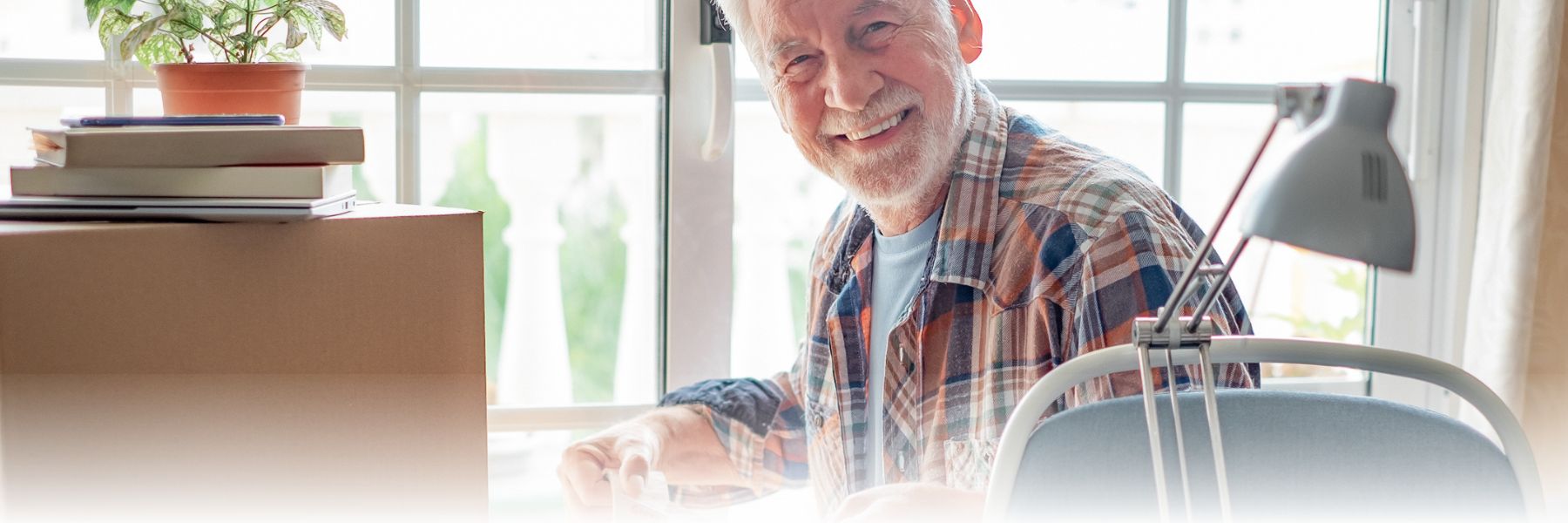
Let’s Get Downsizing
Downsizing your home can be overwhelming. Sorting through your belongings and deciding what to keep and what to part with is a time-consuming task that many of us avoid. However, downsizing before a big event like a move will help you feel more organized and make the unpacking process so much easier! Don’t let your stuff overwhelm you and stop you from taking on the task of decluttering your home. Following the below tips will help make the process easier and more manageable for you.
What’s Your Downsizing “Why?”
Take some time to ask yourself why you want to downsize. It may help prevent you from tackling too many downsizing projects at once.
Do you need to save money?
Big homes usually come with big repair bills and monthly payments. A smaller home may give you more money at the end of your month and allow you to save more money for emergency savings or retirement. Some senior living communities only require a flat monthly payment so you always know what to expect without any surprise bills.
Is your space cramped?
Sometimes downsizing is just about having too many things packed into the space you have. Maybe it’s time to trade in the huge sectional couch for a small sofa and loveseat. Or you might need to go through all the boxes to see what’s in them, and more importantly, whether you should keep any of it.
Are you going through a life change?
Are your children moving away and you need a smaller space that’s easier to maintain? Or are you retiring and wanting to move to a senior living community? If your next move lands you in a smaller space, downsizing your belongings before you move will help make for a smooth transition to your new home.
Is the space safe for you?
Older adults may find a large home more challenging in which to get around. Maintaining a larger home is more expensive, making it a financial burden for older adults.

How to Downsize Your Home
When it comes to downsizing your space, it can be a bit overwhelming at first. But don’t worry, Here are some great tips to help you out.
1.) Start now
Giving yourself weeks and months to sort through your house will help you get into a routine and avoid tossing something you’ll miss later. Sorting through old possessions might sound easy, but without a plan, it can quickly become emotional and messy—especially if you’re sorting through various belongings simultaneously. Sitting down and writing a plan of action clarifies your thoughts and provides a useful resource in case things become more complicated than expected. Research local places that accept donated or thrifted items; they’ll be helpful after you’ve sorted your possessions
2.) Learn how to declutter
If you’re not sure where to start, try some of these helpful tips.
- Give one item away each day. With 365 days in a year, you could make headway faster than you realize.
- Speed fill a trash bag. Grab your stopwatch and the nearest pile of stuff and start filling the bag. Once it’s done, head straight to your local donation drop-off.
- Try the reverse-direction clothes hanger trick. Hang all the clothes in your closet backwards, and only correct them when you wear them. Get rid of the ones that are still reversed after a month or two.
- Share your before and after photos on social media. Pick a space and post the before and after pics in your feed as you clear it out. You’ll see your progress and even encourage others.
- Give the four-box method a shot. Label four boxes as trash, donate, keep or store. Each day, make sure one thing goes into each box. Speed things up by increasing the number of items that go into each box until you fill them up, then start over.
3.) Take inventory of what you have.
Once you start decluttering, you’ll probably see a pattern to the items you plan to keep and those you plan to get rid of. That will make it easier to start making an inventory list room by room.
You may be surprised by how many duplicates and unused items you have, that you haven’t used in years. Categorizing your things will make it easier to organize them when deciding what to keep or discard. Categories might include such things as garage tools, linen closet items, kitchen supplies, and more. Map out these categories in the written plan.
Pack by category in the corresponding room. Tackling one room at a time is much easier than sorting through the entire house at once. This is also a good opportunity to digitize belongings that don’t need a physical copy, such as personal documents or family photos.

4.) Have a plan for getting rid of things
Sort your belongings in four piles, or better yet try the four-box method with the following categories: keep, trash, donate or store.
- Keep. Your keep box is for those items you know without thinking you’ll be hanging onto. Make sure you clearly label this box and set it in a separate area, so you don’t inadvertently send it with the donation box.
- Trash. There should be no “maybes” in the trash pile. You know these items are done, and you want to make it a habit to add the trash box items to your regular garbage pick-up bins to avoid the temptation to go back in the box and second-guess what you’re throwing out.
- Donate. No matter what your charity is, the donation box should be clearly marked.
- Store. If you don’t have the heart to get rid of some belongings, give them a new home in storage. You may find the emotional pull you felt for the “store” box wanes after you’ve paid the storage bill for a few months.
5.) Sell your extra furniture
Large furniture pieces like hutches and sectional couches may not fit well in a small home but may sell for a nice price if you sell them online. Consider setting aside the sale proceeds to pay for new items that take up less square footage in your home.
If you plan to downsize to a smaller home or a retirement community, check out models to get an idea of the mix of furniture pieces that will fit. You may even want to bring a measuring tape and notepad to keep track of the furniture dimensions you like.

6.) Pick your storage options
If you’re just not ready to part with some of your belongings, start looking at storage options in your area. The more space you need, the more you’ll spend. Depending on what you’re storing and where you live, you may need climate-controlled space to preserve items that might be sensitive to weather extremes, which will add to your monthly cost. This is especially important in humid climates – an air-conditioned unit might protect your belongings from extreme heat and cold, but a climate-controlled space protects your wood and leather furniture, artwork, and other humidity-sensitive items from damage.
7.) Take your time
Unless your downsizing needs are urgent, pace yourself with one space or room at a time. If your home is filled with boxes and piles of stuff everywhere, you’re more likely to give up if you try to sort through everything in a short time, rather than if you set a schedule to focus on one room, closet or even just one box at a time.
8.) Have a Yard Sale
Yard sales are a great way to generate extra income before a move, especially since the cost of movers can be high. There’s also the added benefit of your belongings finding a new home instead of ending up in the trash or collecting dust on a thrift store shelf.
Embrace a Simplified Lifestyle
Whether you’re doing the move yourself or hiring a moving company, downsizing doesn’t have to be difficult with some planning. Whether you’re buying a smaller home or moving to a retirement community like The Ohio Masonic Communities, taking the time to declutter and streamline your belongings will make the whole moving process much smoother and less stressful. It’s all about creating a fresh start and embracing a more simplified lifestyle.
Wanting more tips about downsizing and simplifying your space? The Ohio Masonic Communities is your go to resource. With three locations in Springfield, Waterville, and Medina, OH, their senior living communities offer 24/7 care and support for independent living, assisted living, and memory care. If you and your loved one are interested in senior living, schedule a tour at one of the scenic and beautiful communities. Call (877) 881-1623 today to learn more about their great senior living options.